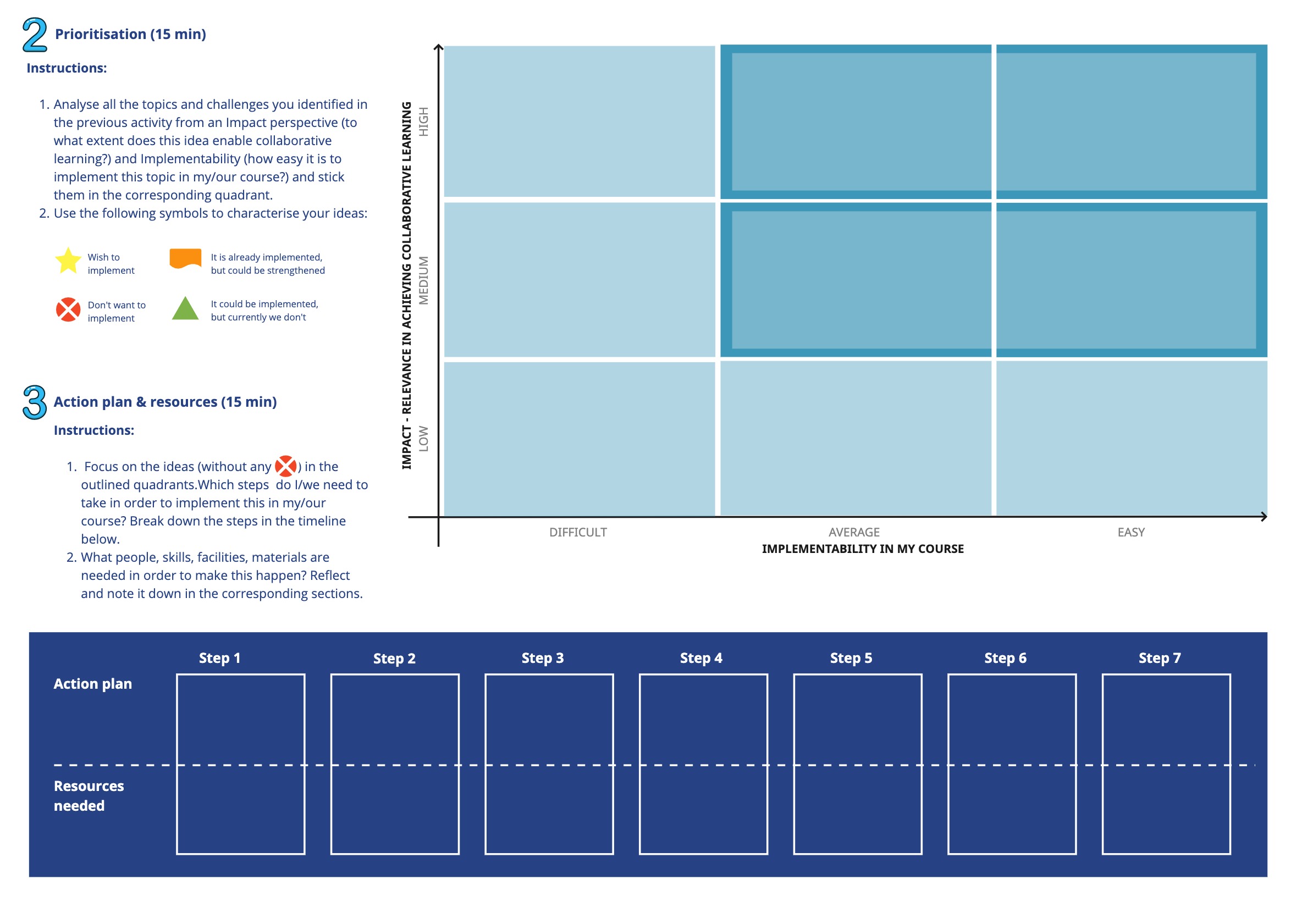Collaborative Learning
How might we (re)design my course so that students learn in a collaborative way? In this workshop, you will brainstorm ways in which students can work with others to develop solutions to challenges. Students work together to identify problems, generate ideas, test, and refine solutions. Through collaboration, students develop teamwork and communication skills, and a shared sense of purpose.
Duration
60-90 min.
Materials
For live session: post-its, pens, printouts of worksheets. For online session: Miro template, charged laptop, internet.
People
2-6 people, 1 facilitator.
Preparation
It is recommended to have a basic understanding of constructive alignment prior to using this workshop. Learning objectives and assessment should be pre-defined.
Follow the steps of this workshop, to go from brainstorming on the topic of collaborative learning, to prioritising and developing an action plan for (re)design of your course/project.
The first activity of this workshop is called Collaborative learning double-diamond worksheet. At this stage, you are asked to think out of the box and brainstorm as many ideas as you can on the topic. Follow the instructions below:
Instructions:
- Read the “How Might We… Question” in the yellow post-it.
- Take the double-diamond model and follow the prompt questions: what learning activities can you think of that will enable student teams to diverge in coming up with a solution to the challenge? Write them in the first half of the first diamond.
- Next focus on the second prompt: what learning activities can you think of that will enable student teams to converge in coming up with a solution to the challenge?
- Now focus on the first decision point and follow the prompt: what activities can help the students make decisions together?
- Repeat the process for the second diamond. You can repeat the process as many times as you wish, based on how many iterations you’d like to have your students go through.
Now that you have brainstormed a lot of ideas for collaborative learning within your curriculum, it is time to start prioritising.
Instructions:
- Analyse all the ideas you came up with in the previous activity from an Impact perspective (how much this idea will enable students to work in a collaborative way?) and Implementability (how easy it is to implement this topic in my/our course?) and stick them in the corresponding quadrant.
- Use the symbols that you find on the canvas to characterise your ideas: is it something that you wish to implement in your course? Or not at all? Is it something that is already somewhat implemented but could be strengthened? Or is it something that could be implemented, but you are currently not?
Now that you have a clearer overview of which ideas have more potential than others to be implemented, it is time to create an action plan!
Instructions:
- Focus on the ideas (that you haven’t marked with “Don’t want to implement”) in the outlined quadrants of the 3×3 template. Which steps do I/we need to take in order to implement this in my/our course? Break down the steps in the blue timeline on the canvas.
- What people, skills, facilities, materials are needed in order to make this happen? Reflect and note it down in the corresponding sections, named “Resources needed”.
At this point, you have a complete overview of which ideas you can integrate in your course and a step-by-step how to guide. Well done!
Resources and downloads
You can access the PDF worksheet canvases through the download button: they are ready for print.

Hey, this Chiara, Education Designer at TU/e innovation Space. How can I help you?
This toolkit is meant to be constantly evolving and improving. Do you have any questions or feedback to make this better? Or do you need help with the toolkit? Get in touch!

